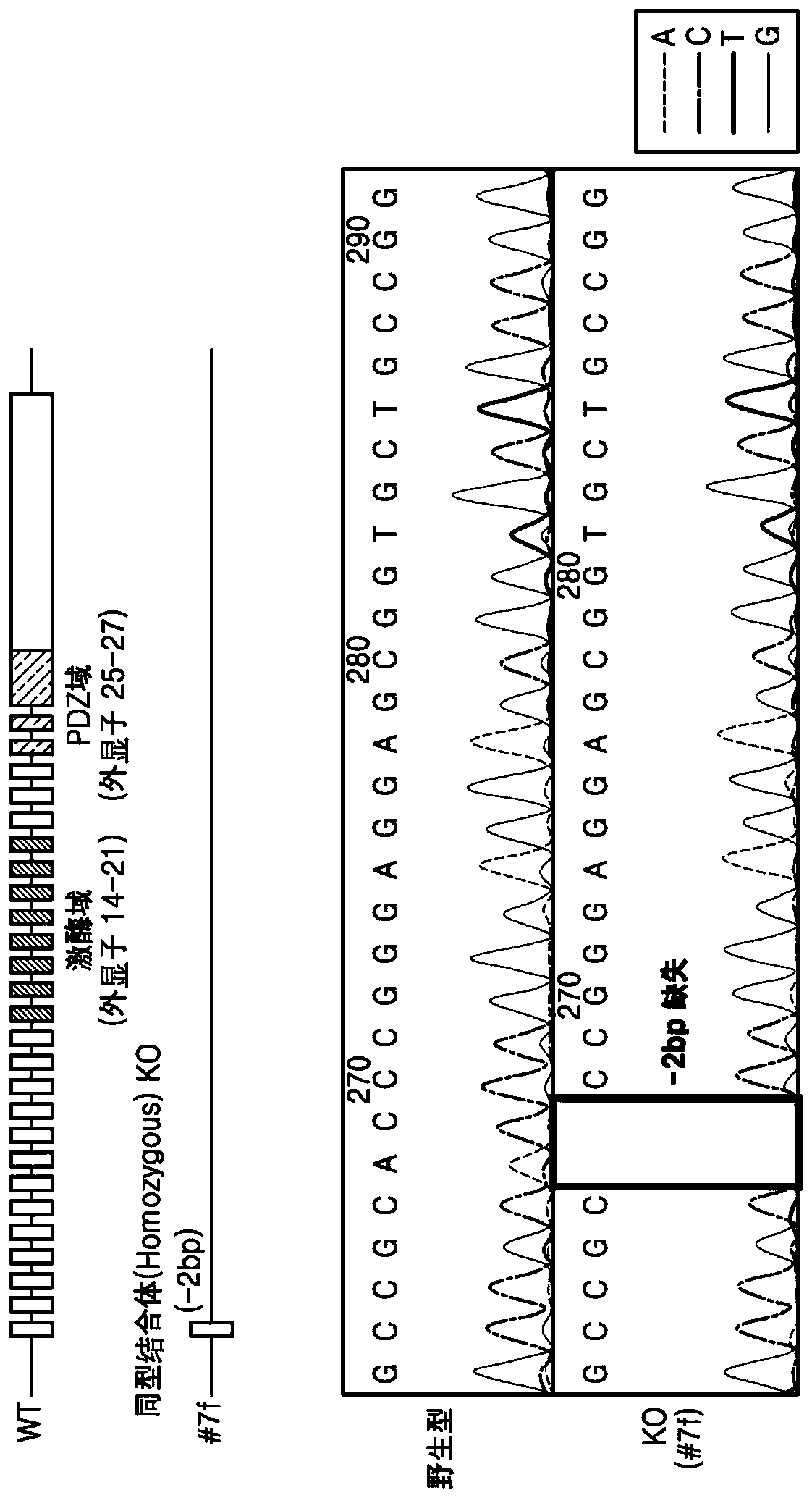Extracellular matrix-producing composition using mast4 gene and preparation method therefor
A technology of composition and extracellular matrix, applied in the field of composition and preparation thereof for producing extracellular matrix using MAST4 gene, capable of solving problems such as not elucidating specific functions
- Summary
- Abstract
- Description
- Claims
- Application Information
AI Technical Summary
Problems solved by technology
Method used
Image
Examples
Embodiment 1
[0079] Example 1. Confirmation of increased expression of cartilage components in MAST4 knockout mice
[0080] 1-1. Using CRISPR / Cas9 system to construct MAST4 knockout mice
[0081] In order to confirm whether the extracellular matrix, which is a component of cartilage, increases when MAST4 expression is suppressed, the CRISPR / Cas9 system was first used to construct MAST4 knockout mice.
[0082] Specifically, to prepare CRISPR knockout mice, pX330-U6-Chimeric_BB-CBh-hSpCas9 (Addgene, #42230) donated by Dr. Feng Zhang (Cong et al., 2013) was used as a plasmid capable of expressing Cas9 mRNA and guide RNA. Since MAST4 is a large protein of more than 7kb, it is designed to perform gene editing for exon 1 and exon 15, and the guide RNA sequence targeting MAST4 exon 1 is 5'-GGAAACTCTGTCGGAGGAAGGGG-3' , the sequence targeting exon 15 is 5'-GGCACAAAGAGTCCCGCCAGAGG-3'. Oligomers indicated in the MAST4 CRISPR Oligomer Table below were prepared according to the manufacturer's protoco...
Embodiment 2
[0110] Example 2. Confirmation of increased expression of cartilage components in MAST4 knockout cells
[0111] 2-1. Using CRISPR / Cas9 system to construct MAST4 knockout cells
[0112] To confirm whether the increase in extracellular matrix exhibited in MAST4 knockout mice was identically reproduced in vitro, the CRISPR / Cas9 system was used to prepare MAST4 knockout cells.
[0113] Specifically, it was a fibroblast cell from a mouse, and C3H / 10T1 / 2, clone 8, which could differentiate into chondrocytes was purchased (Gift from Prof. Jeong Seonyong, Department of Medical Genetics, Ajou University School of Medicine, Korea). To knock out the cells, lentiCRISPRv2 (plasmid #52961), pVSVg (AddGene 8454) and psPAX2 (AddGene 12260) were purchased from Addgene and the oligos in Table 5 below were used according to the supplier's instructions (lentiCRISPRv2 and lentiGuide oligo cloning protocol ) A guide RNA targeting exon 1 of the mouse MAST4 gene (ENSMUSG00000034751) was inserted i...
Embodiment 3
[0121] Example 3. Confirmation of micromass culture and increase in chondrogenic differentiation activity in MAST4 knockout cells
[0122] 3-1. Micromass culture of MAST4 knockout cells
[0123] In order to evaluate the chondrogenic ability of the MAST4 knockout cells of Example 2-2, micromass culture was performed.
[0124] Specifically, MAST4 knockout cells were prepared as described in Example 2-1, and were carried out with reference to conventionally known methods for micromass culture (Differentiation and Mineralization of MurineMesenchymal C3H10T1 / 2Cells in Micromass Culture, 2010, Rani Roy) . First, 10 μl of culture solution containing a total of 105 cells in the fibroblast state was placed in the center of each well of a 12-well plate, and after incubation for 2 hours, 1 ml of DMEM containing 10% FBS was added to each well. Then, 100 ng / ml, 500 ng / ml and 1000 ng / ml of BMP2 were added to each culture according to the purpose of induction to cartilage. Thereafter, rep...
PUM
 Login to View More
Login to View More Abstract
Description
Claims
Application Information
 Login to View More
Login to View More - R&D
- Intellectual Property
- Life Sciences
- Materials
- Tech Scout
- Unparalleled Data Quality
- Higher Quality Content
- 60% Fewer Hallucinations
Browse by: Latest US Patents, China's latest patents, Technical Efficacy Thesaurus, Application Domain, Technology Topic, Popular Technical Reports.
© 2025 PatSnap. All rights reserved.Legal|Privacy policy|Modern Slavery Act Transparency Statement|Sitemap|About US| Contact US: help@patsnap.com



